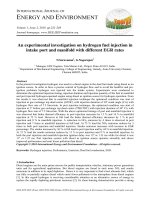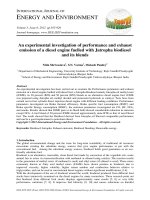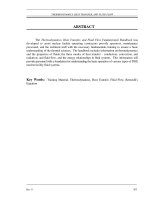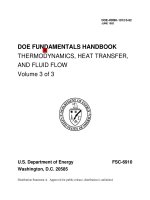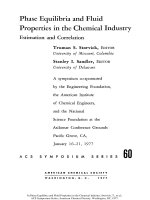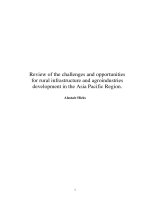An experimental investigation of heat transfer and fluid flow in a rectangular duct with inclined discrete ribs
Bạn đang xem bản rút gọn của tài liệu. Xem và tải ngay bản đầy đủ của tài liệu tại đây (482.37 KB, 12 trang )
I
NTERNATIONAL
J
OURNAL OF
E
NERGY AND
E
NVIRONMENT
Volume 1, Issue 6, 2010 pp.987-998
Journal homepage: www.IJEE.IEEFoundation.org
ISSN 2076-2895 (Print), ISSN 2076-2909 (Online) ©2010 International Energy & Environment Foundation. All rights reserved.
An experimental investigation of heat transfer and fluid
flow in a rectangular duct with inclined discrete ribs
K. R. Aharwal
1
, B. K. Gandhi
2
, J. S. Saini
2
1
Department of Mechanical Engineering S.G.S.I.T.S. Indore (M.P.), India.
2
Department of Mechanical and Industrial Engineering I.I.T. Roorkee (U.A.), India.
Abstract
Artificial roughness in the form of repeated ribs is generally used for enhancement of heat transfer heated
surface to the working fluid. In the present work experimental investigations has been carried out to
study the effect of a gap in the inclined rib on the heat transfer and fluid flow characteristics of heated
surface. A rectangular duct of aspect ratio of 5.83 has been used to conduct experiments on one rib
roughened surface. Experimental data have been collected to determine Nusselt number (heat transfer
coefficient) as a function of roughness and flow parameters in the form of repeated ribs. In order to
understand the mechanism of heat transfer through a roughened duct having inclined rib with and
without gap, the detailed analysis of the fluid flow structure is required. Therefore the detailed velocity
structures of fluid flow inside a similar roughened duct as used for the heat transfer analysis were
obtained by 2-Dimensional Particle Image Velocimetry (PIV) system and the heat transfer results were
correlated with the flow structure. It was found that inclined rib with a gap (inclined discrete rib) had
better heat transfer performance compared to the continuous inclined rib arrangement. Further the
inclined discrete rib with relative gap width (g/e) of 1.0 gives the higher heat transfer performance
compared to the other relative gap width.
Copyright © 2010 International Energy and Environment Foundation - All rights reserved.
Keywords: Artificial roughness, Relative gap position, Reynolds number, Nusselt number.
1. Introduction
A Large number of studies on heat transfer and flow characteristics have been carried out to investigate
the effect of rib design parameters namely rib height, angle of attack, relative roughness pitch, rib
arrangement and rib cross-section. However, the artificial roughness results in higher frictional losses
leading to excessive power requirement for the fluid to flow through the duct. It is therefore desirable
that turbulence must be created only in a region very close to the heat-transferring surface to break the
viscous sub-layer for augmenting the heat transfer and the core flow should not be unduly disturbed to
limit the increase in friction losses. This can be done by keeping the height of the roughness elements
small in comparison to the duct dimensions [1]. Han et al. [2] investigated the effect of angle of
attack
()
α
and relative roughness pitch (P/e) on heat transfer and friction characteristics of rectangular
duct with two roughened side walls. They reported that the maximum values of heat transfer coefficient
and friction factor occur at relative roughness pitch of 10 at an angle of attack of 45° compared to the
other rib arrangements under the requirements of same pumping power. Han et al. [3] reported that the
rib configuration with relative roughness pitch of 7.5 gives higher enhancement in heat transfer than that
International Journal of Energy and Environment (IJEE), Volume 1, Issue 6, 2010, pp.987-998
ISSN 2076-2895 (Print), ISSN 2076-2909 (Online) ©2010 International Energy & Environment Foundation. All rights reserved.
988
of the relative roughness pitch of 10 or 5. Webb et al. [4] have reported that the maximum heat transfer
occurred at the relative roughness pitch of 6 to 8.
Kiml et al. [5] reported that the rib roughness arrangement with an angle of attack of 60°
shows better
heat transfer performance compared to that of the 45° rib arrangement. Lau et al. [6, 7] investigated the
heat transfer and friction factor characteristics of fully developed flow in a square duct with transverse
and inclined discrete ribs. They reported that a five- piece-discrete transverse ribs shows 10-15% higher
heat transfer coefficient as compared to continuous transverse ribs, whereas inclined discrete ribs give 10
to 20% higher heat transfer rate than that of the transverse discrete ribs. Hu et al. [8] investigated the
effect of inclined discrete rib with and without groove and reported that discrete rib arrangement without
groove shows better thermal performance than that of the discrete rib with groove.
Gao and Sunden [9] conducted experiments in rectangular ducts with 90°, 60°, 45° and 30° ribs using
PIV system to investigate the effect of rib inclination on the flow field for a constant value of the system
parameters such as ratio of rib height to hydraulic diameter (as 0.06), pitch to rib height ratio (as 10) and
Reynolds number as 5800. They used three different planes to analyze the flow field using PIV system.
They observed that the strength of the secondary flow of 60° rib is higher compared to the other angles of
attack. The PIV results obtained for 90° ribs were compared with the data available with Laser Doppler
Velocimetry (LDV) system which showed good agreement Bonhoff et al. [10] investigated the flow
structure of coolant channel roughened with 45° inclined ribs on two opposite surfaces using PIV system.
They validate the results of numerical analysis with observation of PIV system. Gao and Sunden [11]
have used PIV system to measure the flow field in a rectangular duct with 60º inclined and V-shaped rib
arrangements in three planes and reported that the PIV technique is capable of obtaining the detailed flow
structures between two consecutive ribs with reasonable accuracy.
In a recent study, Cho et al. [12] investigated the effect of a gap in the inclined rib on heat transfer in a
square duct and reported that a gap in the inclined rib accelerates the flow and enhances the local
turbulence which will result in an increase in the heat transfer. They reported that the inclined rib
arrangement with a downstream gap position shows higher enhancement in heat transfer compared to
that without a gap i.e. of the continuous rib arrangement.
Most of the investigations carried out so far have applied the artificial roughness on two opposite walls
with all four walls being heated. However in the case of solar air heaters, the roughness elements have to
be considered only on one wall, which is the only heated wall comprises of the absorber plate. These
applications make the fluid flow and heat transfer characteristics distinctly different from those found for
ducts with two roughened walls and four-heated walls. For simulating the conditions of solar air heater,
only one wall of the rectangular duct is to be subjected to uniform heat flux (to substitute insolation)
while the remaining three walls are to be kept insulated. Many investigators [13-19] have employed
artificial rib roughness in various forms on to improve the thermal performance of solar air heater. They
reported that the geometry of the rib namely shapes, height, angle of attack and pitch affects significantly
the heat transfer and friction characteristics of the duct.
The literature review reveals that the discrete inclined rib arrangement yields better performance as
compared to continuous rib arrangement. However investigations have not been carried out so far to
optimize the gap width for discretization of the continuous rib. The present investigation was therefore,
taken up to determine the optimum width of a gap in the inclined rib to form discrete rib. This study will
help in determining the gap size while descritizing the inclined (non-transverse) ribs for enhancing the
performance as compared to continuous ribs. To investigate the effect of gap width on the flow field a
Two Dimensional Particle Image velocimetry (2-D PIV) system is used. The PIV results have been
compared with the enhancement of heat transfer to correlate the flow field investigation with the
mechanism of heat transfer.
2. Experimental setup
Two experimental set-ups, one for heat transfer analysis and other for fluid flow analysis has been
designed and fabricated to study the effect of a gap in the inclined rib roughened rectangular duct. A
schematic diagram of the experimental set up for heat transfer analysis is shown in Figure 1. The wooden
rectangular duct has an internal size of 2600 mm x 181 mm x 31 mm which consists of entrance section,
test section and exit section of lengths of 800 mm, 1200 mm and 600 mm respectively according to the
guidelines of ASHARAE standard [20]. A 6 mm thick Aluminum plate, roughened artificially at the
wetted side, is used as the top broad wall of the test section whereas the upper walls of entry and exit
sections of the duct were made of 12 mm thick plywood. The absorber plate is heated from the top by
International Journal of Energy and Environment (IJEE), Volume 1, Issue 6, 2010, pp.987-998
ISSN 2076-2895 (Print), ISSN 2076-2909 (Online) ©2010 International Energy & Environment Foundation. All rights reserved.
989
supplying a constant heat flux through an electrical heater, which was insulated by 50 mm thick glass
wool and 12 mm thick plywood. A calibrated orifice-meter is used to measure the mass flow rate of air
by measuring the pressure drop through a U- tube manometer with kerosene as manometric fluid. A Betz
micro-manometer is used to measure the pressure drop across the test section. Calibrated thermocouples
have been used for monitoring the temperature variations. The airflow rate has been varied with the help
of a control valve to conduct the test in the flow Reynolds number range of 3000 to 18000. Data are
collected for study-state condition only, which is assumed to have been reached when the plate and the
air temperatures do not show any significant variation for 10-minutes duration.
1. Entrance section, 2. Absorber plate, 3. Air duct (passage), 4. Micro manometer, 5. Electrical heater, 6.
Thermal insulation 7. Exit section 8. Transition section 9. G. I. pipe 10. U-Tube manometer 11. Orifice
meter 12. Flexible pipe 13. Control valve 14. Blower, P- Pressure tap, TC - Thermocouple
Figure 1. Schematic diagram of experimental setup
For flow structure visualization through a two dimensional PIV system, a similar experimental with the
modification in the entrance section and test section of the duct were used. A schematic diagram of flow
visualization experimental set-up is shown in Figure 2. In the entrance section, an additional attachment
called “plenum” is provided for proper mixing of the seeding particles with the working fluid (i.e. air). In
order to visualize the velocities in the test section, its three sides (top and two side walls) were made of
transparent acrylic sheet, and the roughened plate is fixed at the bottom side.
2D-PIV system consists of Laser source, Laser optics, Camera, Synchronizer, Seed generators and
Software. The laser source is equipped with two separate ND-YAG lasers, so that the laser can be pulsed
one after another and emits light at a wave length of 532 nm with a power output of each laser as 50 mJ
per pulse. The light sheet dimensions can be modified by using the laser sheet optics containing spherical
and cylindrical lenses.
A high performance (CCD) camera is used to record the motion of the particles moving in the plane of
the laser sheet. In the present system, 2-mega pixel camera with internal and external triggering
arrangement is used. A Nikon AF Micro- Nikkor 60 mm f/2.8 lens was used with the CCD camera for
flow visualization. The operation of the laser and the camera is controlled through the synchronizer.
Trigger signal output from the synchronizer controls Nd: YAG laser pulsing sequence so that the laser
pulses are located in the appropriate frames in the camera. The entire system is controlled and operated
by a computer using INSIGHT 6.11 data analysis software. A six jets atomizer (TSI Model 9306) is used
to seed the liquid droplets inside the duct. The atomizer works well under input pressures between 1.4 to
3.5 bar.
International Journal of Energy and Environment (IJEE), Volume 1, Issue 6, 2010, pp.987-998
ISSN 2076-2895 (Print), ISSN 2076-2909 (Online) ©2010 International Energy & Environment Foundation. All rights reserved.
990
Figure 2. Schematic diagram of experimental set up for PIV measurement
3. Roughness geometry
Figure 3 shows the roughness geometries employed for heat transfer analysis and flow analysis. The
absorber plates were machined to develop integral ribs on the surface of an Aluminum plate. The height
and width of the ribs were kept equals to 2 mm. A gap in the continuous rib has been made at a distance
of 0.25 times of the duct width, measured from the trailing edge portion (see Figure 3). The relative
roughness pitch (P/e) defined as the ratio of pitch to rib height and the relative roughness height (e/D),
defined as the ratio of rib height to hydraulic diameter are kept as 8 and 0.037 respectively. The relative
gap width (g/e), defined as the ratio of gap width to rib height, is varied from 0.5 to 2.0 for the rib
inclined at 60º from the flow direction as shown in Figure 3. In our previous study [21], it was observed
that inclined rib with relative gap position of 0.25 and relative roughness pitch of 8.0, with an angle of
attack of 60º and with relative roughness height of 0.037 performers better then the other relative gap
position. Therefore in the present study these parameters were kept constant and only the relative gap
width was varied to see the effect of this parameter on enhancement of heat transfer.
For the flow visualization inside a rectangular roughened duct the test facility should be designed in such
a way that it will allow to take the measurement in different planes in order to measure the different
velocity components. Since the flow through the multi-ribs could not be visualized therefore it is planed
to prepare a roughened surface of single rib inclined at an angle of 60º to investigate the flow through
this rib under condition of with and without a gap in the rib. The relative gap position is kept as 0.25 and
the relative gap width (g/e), defined as the ratio of gap width to rib height, is varied from 0.5 to 2.0. The
flow is in two planes namely, plane A and B (see Figure 3) has been visualized through 2D PIV system.
In plane A, the laser sheet was adjusted parallel to the direction of main flow while, the camera was kept
perpendicular to the main flow direction. In plane B the laser sheet was kept perpendicular to the
orientation of the rib and the camera was put along the rib direction (Figure 4). The rib and susequent
surface was painted black to decrease the noise signals due to the light scattered by the rib, which would
then create invalid velocity vectors.
Figure 3. Roughness geometries used for the analysis of heat transfer
International Journal of Energy and Environment (IJEE), Volume 1, Issue 6, 2010, pp.987-998
ISSN 2076-2895 (Print), ISSN 2076-2909 (Online) ©2010 International Energy & Environment Foundation. All rights reserved.
991
Figure 4. Laser sheet arrangement for PIV measurement of single rib
4. Results and discussion
The results of experimental investigation of heat transfer and flow characteristics of the roughened ducts
are presented as a roughness parameters. The variation of the Nusselt number with Reynolds number as a
function of relative gap width is shown in Figure 5. It is seen that the value of Nusselt number increases
with increase in relative gap width up to 1.0 and then decrease with further increase in the relative gap
width at all Reynolds numbers. The lowest value of Nusselt number is observed at the relative gap width
of 2.0. To bring out the effect of relative gap width clearly, variation of Nusselt number, shown in Figure
5 is re-plotted in Figure 6 with the relative gap width at few selected values of Reynolds numbers. It
shows that at all the values of Reynolds number, the Nusselt number increases with increase in the
relative gap width up to 1.0, beyond which it decreases with further increase in relative gap width. The
possible explanation for increase in the heat transfer due to a gap is that the gap in the inclined rib
releases the air partly belonging to the secondary flow and partly belonging to the main flow through the
gap. As a result of the presence of gap, the secondary flow along the rib joins the main flow to accelerate
it which energizes the retarded boundary layer flow along the surface leading to an increase in the heat
transfer through the gap width area behind the rib. It seems that increase in the gap width reduces the
flow velocities through the gap and hence the local turbulence. At the same time a very small gap will
also not allow sufficient amount of the secondary flow fluid to pass through it and thus the main flow
could not be energized well. This may have resulted in the observation of the maximum value of the
Nusselt number at a certain value of gap width namely relative gap width of 1.0 only.
Figure 5. Variation of Nusselt number with Reynolds number as a function of relative gap width for P/e
= 8.0, d/W = 0.25, α = 60 and e/D = 0.037
